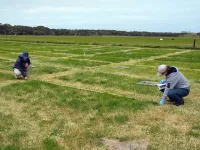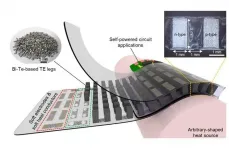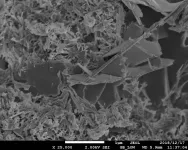(Press-News.org) January 13, 2021 - The element nitrogen is a double-edged sword. It is essential for growing plants and feeding people, but it is also a leading cause of pollution across the world. Only by using nitrogen more sustainably can the positive and harmful effects of nitrogen be balanced.
Xia (Emma) Liang, a member of the American Society of Agronomy, studies nitrogen loss during food production.
Liang and her team created a framework that accurately measures nitrogen loss across a wide variety of crops and food products. She recently presented their research at the virtual 2020 ASA-CSSA-SSSA Annual Meeting.
"This framework can capture the environmental impacts and societal costs of nitrogen losses," Liang explains. "This allows us to potentially provide information to inform consumers, producers, and policymakers."
The team hopes this research will help make major progress in making agricultural systems across the world more sustainable, less polluting, and more profitable.
Their framework measured both overall nitrogen loss and nitrogen loss intensity. The latter is the loss per unit of food or per unit of nitrogen produced. This allowed better comparisons across different crops and food items.
For example, cereal grains have a low loss intensity but a high overall loss because they are grown in such large quantities. On the other hand, an animal product like buffalo meat has a high loss intensity but a low overall loss. This is due to the small amount produced.
The framework reveals that the loss quantity and loss intensity vary a lot for different food products, especially when compared between farmers and countries. The database includes 115 crop and 11 livestock commodities at the global scale.
Cattle contribute the most to global nitrogen pollution. They are followed by the production of rice, wheat, maize, pork, and soybeans. Beef is also the food with the highest loss intensity, followed by lamb, pork and other livestock products. Generally, the loss intensity of livestock is much larger than the loss intensity of crop products.
"The lowest nitrogen loss for the 11 livestock products exceeds that of vegetable substitutes," Liang says. "This confirms the importance of dietary change to reduce nitrogen loss through consumption."
The nitrogen loss from fields can cause harm in multiple ways. It can cause smog and further climate change. It harms soil and water, as well as the plants and animals that live there. For humans, high levels of nitrogen in the air and water have been connected to illness.
Liang highlights that with current activities, the planet's nitrogen boundary, a "safe operating space" for humanity, is exceeded by over two-fold.
Solutions are complex. On farms themselves, there are many techniques to better manage nitrogen. These include better fertilizer technologies and practices, improved crop varieties, and following the "4 Rs." This means using the right fertilizer in the right amount at the right time in the right place. There are also ways to improve nitrogen management in livestock.
However, Liang explains that on-the-farm solutions are only half the battle. An economic approach is also needed.
"An economic approach would provide incentives for adopting better nitrogen management practices," she says. "For instance, incentives should be given to promote sustainable measures to maintain the soil nitrogen. These include reducing the risk of soil degradation and erosion and the overuse of fertilizers."
Individuals can also adopt helpful changes, she adds. Reducing consumption of meat and reducing food waste are two options. Another is having discussions about sustainable nitrogen management.
"When we buy a washing machine or a car, we can choose a more water efficient and energy efficient product by water and energy rating," Liang says. "However, despite growing recognition of the importance of nitrogen in sustainable food production and consumption, we don't follow a similar idea for foods we eat."
INFORMATION:
Xia (Emma) Liang is an agriculture researcher at the University of Melbourne. This research was supported by the University of Melbourne Research Initiatives Fund Grant Scheme of the Faculty of Veterinary and Agricultural Sciences, Meat Livestock Australia, Australia Research Council, Australia-China Joint Research Centre, Healthy Soil for Sustainable Food production and Environment and Incitec Pivot Limited.
Learn more about the environmental impacts of agronomy. The ASA-CSSA-SSSA Annual Meeting was hosted by the American Society of Agronomy, Crop Science Society of America, and the Soil Science Society of America.
A thermoelectric device is an energy conversion device that utilizes the voltage generated by the temperature difference between both ends of a material; it is capable of converting heat energy, such as waste heat from industrial sites, into electricity that can be used in daily life. Existing thermoelectric devices are rigid because they are composed of hard metal-based electrodes and semiconductors, hindering the full absorption of heat sources from uneven surfaces. Therefore, recent studies were actively conducted on the development of flexible thermoelectric devices capable of generating energy in close contact with various heat sources such as human skins and hot water pipes.
The Korea Institute of Science and Technology (KIST) announced ...
A rare mineral that has allowed Roman concrete marine barriers to survive for more than 2,000 years has been found in the thick concrete walls of a decommissioned nuclear power plant in Japan. The formation of aluminous tobermorite increased the strength of the walls more than three times their design strength, Nagoya University researchers and colleagues report in the journal Materials and Design. The finding could help scientists develop stronger and more eco-friendly concrete.
"We found that cement hydrates and rock-forming minerals reacted in a way similar to what ...
Researchers from University of Hawaii and University of Florida published a new paper in the Journal of Marketing that argues that a biological account of human behavior, especially undesirable behavior, will benefit human welfare. This biological perspective can complement traditional psychological, anthropological, and economic perspectives on consumption, particularly with respect to the vital topic of self-control.
The study, forthcoming in the Journal of Marketing, is titled "Consumer Self-Control and the Biological Sciences: Implications for Marketing Stakeholders" and is authored by Yanmei Zheng and Joe Alba.
Society's understanding of human ills is constantly evolving. Many ill-advised consumer behaviors are conventionally viewed through a non-biological ...
CLEVELAND--The combined effectiveness of three COVID-prevention strategies on college campuses--mask-wearing, social distancing, and routine testing--are as effective in preventing coronavirus infections as the Pfizer and Moderna vaccines approved by the U.S. Food and Drug Administration (FDA), according to a new study co-authored by a Case Western Reserve University researcher.
The research, published in Annals of Internal Medicine, has immediate significance as college semesters are poised to start again--and as the distribution of approved vaccines lags behind goals.
The study found that a combination of just two common measures--distancing and mandatory masks--prevents 87% of campus COVID-19 infections and costs only $170 per infection prevented. ...
New research from King's College London shows nearly half of Intensive Care Unit (ICU) staff are likely to meet the threshold for PTSD, severe anxiety or problem drinking during the COVID-19 pandemic.
Results from a study of ICU healthcare workers, published today in Occupational Medicine, shows the stark impact of working in critical care during the COVID-10 pandemic. The researchers found poor mental health was common in many ICU clinicians although they were more pronounced in nurses than in doctors or other healthcare professionals.
Lead author, Professor Neil Greenberg, from the Institute of Psychiatry, Psychology & Neuroscience (IoPPN), King's College London said:
'Our results show a substantial burden of mental health symptoms being reported by ICU staff towards the end ...
As schools prepare to re-open to all pupils in February, experts warn that UK government plans for mass testing risks spreading covid-19 more widely.
Writing in The BMJ, Professor Jon Deeks and colleagues at the Royal Statistical Society argue that using the INNOVA rapid lateral flow tests to manage classroom outbreaks, without isolating close contacts, risks increasing disease spread and causing further disruption to children's education.
Before Christmas, schools limited pupil mixing and activities, and isolated pupil groups at home once a covid-19 case was identified, they explain. This year the government is relying on the INNOVA rapid lateral flow tests to mass screen staff and pupils, and test close contacts ...
Crowdsourced Responses from Dermatologists on Twitter Found to be as Effective as Formal Telemedicine
At the start of the pandemic, many doctors on the front lines turned to Twitter and other social media platforms to find guidance and solace directly from their peers. In early 2020, information on COVID-19 had yet to be studied and published in peer-reviewed journals or printed in medical textbooks. Since then, social media has been characterized as both a boon to medical communities seeking real time information and a major driver of misinformation on the virus and its spread. A new study from researchers at the ...
Mothers with multiple children report more fragmented sleep than mothers of a single child, but the number of children in a family doesn't seem to affect the quality of sleep for fathers, according to a study from McGill University.
A total of 111 parents (54 couples and 3 mothers of single-parent families) participated in the study published in the Journal of Sleep Research led by McGill doctoral student Samantha Kenny under the supervision of Marie-Hélène Pennestri, Assistant Professor in the Department of Educational and Counselling Psychology.
Participants' ...
At the start of the pandemic, many doctors on the front lines turned to Twitter and other social media platforms to find guidance and solace directly from their peers. In early 2020, information on COVID-19 had yet to be studied and published in peer-reviewed journals or printed in medical textbooks. Since then, social media has been characterized as both a boon to medical communities seeking real time information and a major driver of misinformation on the virus and its spread. A new study from researchers at the University of Paris provides support for social media as a potentially useful ...
A study of biomass burning aerosols led by University of Wyoming researchers revealed that smoke from wildfires has more of a cooling effect on the atmosphere than computer models assume.
"The study addresses the impact of wildfires on global climate, and we extensively used the NCAR-Wyoming supercomputer (Cheyenne)," says Shane Murphy, a UW associate professor of atmospheric science. "Also, the paper used observations from UW and other teams around the world to compare to the climate model results. The main conclusion of the work is that wildfire smoke is more cooling than current models assume."
Murphy was a contributing author of a paper, titled "Biomass Burning Aerosols in Most Climate Models Are Too Absorbing," that was published ...




